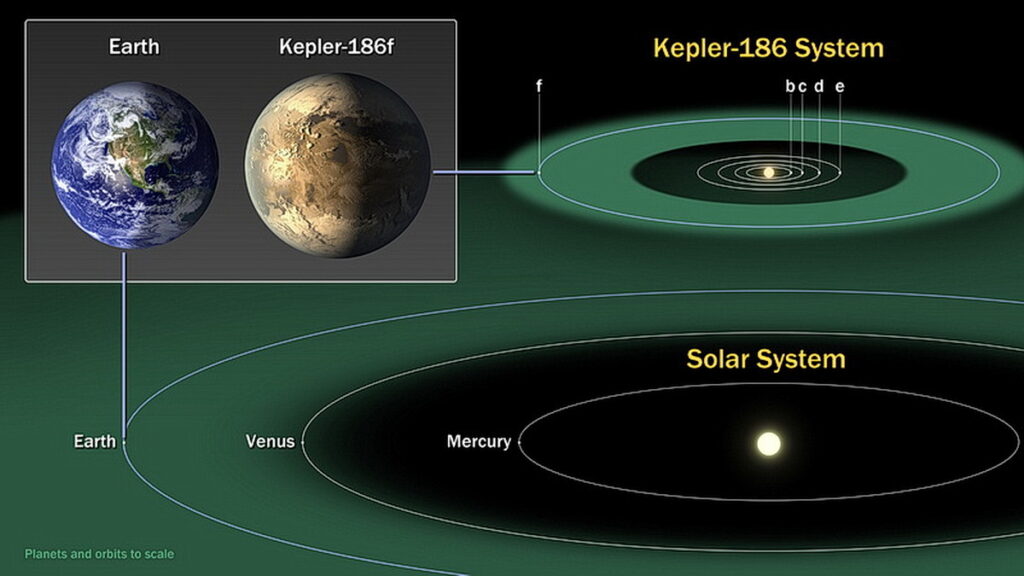Discovery

Johannes Kepler was a 17th-century German astronomer who discovered the systematic rotation of planets around stars, called the Laws of Planetary Motion, it states the following:
- All planets revolve around the Sun in elliptical orbits.
- A radius of the planets moves out in equal areas and in equal lengths of time.
- The squares of the sidereal periods (of revolution) of the planets are directly proportional to the cubes of their mean distances from the Sun. (You don’t have to concern yourself with this law for our article here).
Being that Kepler was a cosmologist who focused his studies on planets, it is fitting that NASA named a spacecraft after him which looks for planets outside of our solar system, called exoplanets.
Specifically, the Kepler Space Telescope is designed to locate exoplanets that exist in the habitable zones, also called the Goldilocks Zone, where conditions are not too hot and not too cold for life as we know it, and which subsequently provides the ingredients for the possibility of liquid water on the planet’s surface. Liquid water is the ingredient that sets the stage for life to cultivate. Water can be found on many planets, some in the form of solid ice, but without water, the possibility of life to develop is minute.
A Perfect Find!
The Kepler spacecraft has not disappointed us. It has located numerous planets that fit this habitual category. Not the least is Kelper-186f, which not only contains an abundance of water but is also similar to Earth in significant ways.

It is an exoplanet that orbits the star Kepler-186 in the constellation Cygnus and is only 500 light-years away from Earth. A mere ‘drop of the bucket’ in distance when considering how incomprehensibly large the universe is.
Kepler’s Sun
Numerous methods are employed to locate these planets. The Kepler telescope uses the transit method which finds celestial objects by observing the periodic dimming of their star’s light as the planet passes in front of it. In other words, it measures changes in the lightness of stars where periodic dips in brightness occur.
Kepler-186f’s star is an M dwarf, which is a red dwarf. Red dwarfs are smaller and cooler than our Sun, and this star is about half the size and half the temperature of our Sun.
The Planet
This orbital body is approximately the same size as Earth, making it one of the first Earth-size, habitable-zoned planets discovered outside of our solar system.
The time it takes Kepler-186f to complete one orbit around its star is approximately 130 Earth days. This is shorter than Earth’s orbit around our sun, which is 365 days, but this does not diminish the possibility of life existing there.
Future Research
Due to the current limitations of technology at this time, the Kepler-186f’s distance, although only 500 light years away, our ability to obtain more detailed information remains a significant challenge.
So further advancements in observational planetary technology are needed to acquire the specifics of distant worlds such as Kepler-186f, but we should look forward to obtaining more information about this exoplanet as it has so much to offer considering its close resemblance to our planet and other physical factors that exist there.
Conclusion
Kepler-186f may not be a perfect match to Earth, but we should not expect it to be. The existence of life is still a good possibility and if we expand our horizons a bit more, we can consider the potential of intelligent life as well; although these beings might not look exactly as we do.
Despite the planet’s location in the habitable zone, several factors could affect a being’s habitability there. One circumstance refers to the planet’s closeness to its red dwarf sun, which might expose it to increased stellar activity (sun spots, solar flares, plasma eruptions) that are greater than from our sun.
This could impact the planet’s atmosphere and surface conditions, resulting in life forms that could have much thicker skin than us, in order to avoid the dangers associated with ultraviolet radiation and x-rays common from stellar actions.

Even a slight change in any external factor on the planet (temperature, light exposure, gravitational pull, etc) may make their appearance look different from us in one way or another. But does it matter? We should welcome them anyway, or should we?
